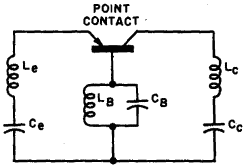| Transistor Basics is a free introductory textbook on transistors and their basic applications. See the editorial for more information.... |

|

Home  Transistor Oscillators Transistor Oscillators  Negative-Resistance Oscillators Negative-Resistance Oscillators  Basic Operation Basic Operation |
||






|
||
|
Basic OperationAuthor: Leonard Krugman If the control of an oscillator can be maintained by simple high or low resistance values in the three transistor electrode arms, the substitution of series and parallel L-C resonant circuits in their place is a natural step. The insertion of a parallel resonant circuit in the base lead will cause the circuit to oscillate at the resonant frequency because of the tank's high impedance at resonance. On the other hand, placing a series L-C circuit in the emitter or collector arms will cause oscillation at the resonance frequency due to the tank's characteristic low impedance at that point. Fig. 6-6 illustrates the a-c equivalent circuit of a negative-resistance oscillator that includes all three methods of controlling oscillation. Since L-C resonant circuits produce sine waveforms, the oscillators using L-C resonant tanks are generally referred to as sine-wave oscillators.
Fig. 6-6. Basic impedance controlled negative resistance oscillator.
|
||
Home  Transistor Oscillators Transistor Oscillators  Negative-Resistance Oscillators Negative-Resistance Oscillators  Basic Operation Basic Operation |
||
Last Update: 2010-11-17


